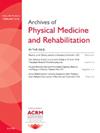Retrospective Examination of Referral Patterns and Predictors of Referral to Cancer Rehabilitation at Canada's Largest Cancer Centre 8256
IF 3.6
2区 医学
Q1 REHABILITATION
Archives of physical medicine and rehabilitation
Pub Date : 2025-04-01
DOI:10.1016/j.apmr.2025.01.020
引用次数: 0
Abstract
Objectives
To describe the sociodemographic and clinical characteristics and symptom burden of patients who were referred to the Princess Margaret Cancer Rehabilitation and Survivorship (CRS) Program between 2017 and 2019 (n=2783), and compare these variables between patients who were referred to CRS and matched cases who were not referred (n=17,025) over this period.
Design
A retrospective case-control secondary analysis of data extracted from the Princess Margaret Cancer Registry, electronic patient records, and patient-reported outcome data (ESAS-r and ECOG status) was performed. Summary statistics describe the patients referred to the CRS program. Multivariable logistic regression modeling was used to identify factors associated with the likelihood of referral.
Setting
Princess Margaret Cancer Centre (CANADA); Canada's largest cancer center.
Participants
Patients diagnosed with cancers of the oropharynx, gastrointestinal tract, respiratory system, breast, gynecologic system, genitourinary system, hematologic and lymphatic systems at Princess Margaret Cancer Centre. Cases were patients newly diagnosed or with recurrence from January 1, 2012 and referred to the CRS program between January 2017 and December 2019 (n=2783). Controls were all unreferred patients, diagnosed in the same months at the same sites (n=17,025).
Interventions
Not applicable.
Main Outcome Measures
Summary statistics were used to describe the patients referred to the CRS program. After this, our analysis was conducted using 4 separate models, to allow us to identify important factors associated with CRS referral and to build a single comprehensive model incorporating both registry and patient-reported factors.
Results
Most referred patients were women (75%), English speakers (93%), and 52% lived within 15 km of Princess Margaret. The most common reasons for referral were musculoskeletal impairment (44.3%), lymphedema (30%), and deconditioning (28%). The mean time from diagnosis to referral was 20.7+19.2 months. Cancer site, age, distance from hospital were the strongest predictors of referral to CRS. Completion of PROMS was also an important predictor; patients who were older, living further from the hospital, from neighborhoods with the least material resources, and incomes in the bottom 80% were least likely to complete the PROMs.
Conclusions
Encouraging and assisting PROM completion, increasing awareness of CRS programming in sites that have lower referrals rates, and addressing referral bias regarding age and distance may increase access to cancer rehabilitation services.
Disclosures
none.
求助全文
约1分钟内获得全文
求助全文
来源期刊
CiteScore
6.20
自引率
4.70%
发文量
495
审稿时长
38 days
期刊介绍:
The Archives of Physical Medicine and Rehabilitation publishes original, peer-reviewed research and clinical reports on important trends and developments in physical medicine and rehabilitation and related fields. This international journal brings researchers and clinicians authoritative information on the therapeutic utilization of physical, behavioral and pharmaceutical agents in providing comprehensive care for individuals with chronic illness and disabilities.
Archives began publication in 1920, publishes monthly, and is the official journal of the American Congress of Rehabilitation Medicine. Its papers are cited more often than any other rehabilitation journal.

 求助内容:
求助内容: 应助结果提醒方式:
应助结果提醒方式:


